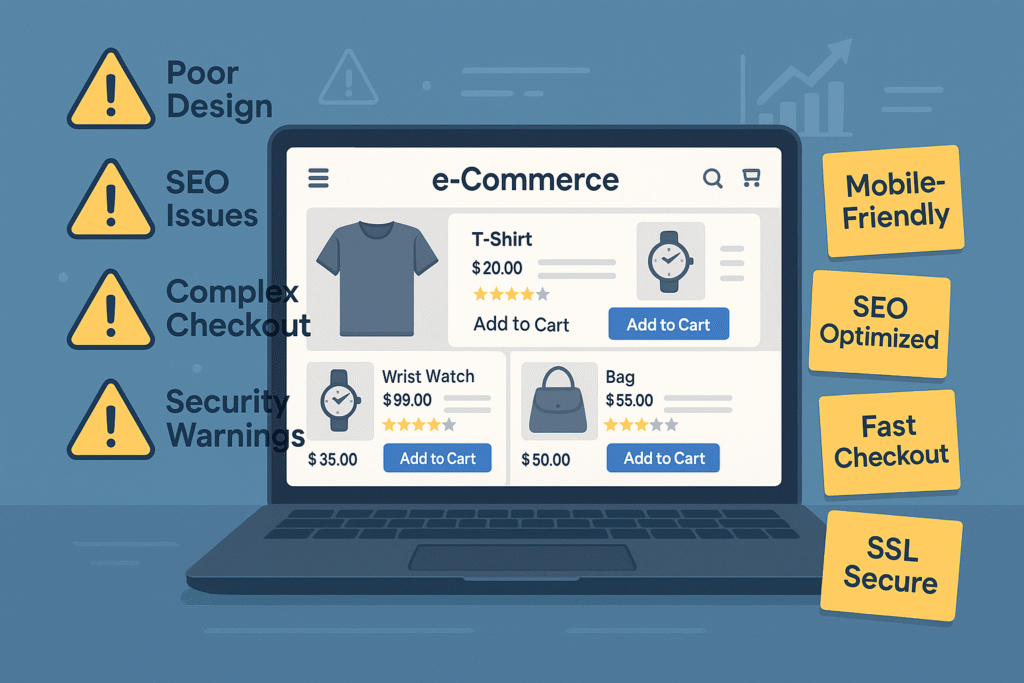Introduction
Need an E-commerce Website for your business? You’re making a smart choice. After all, more people shop online now than ever before. A well-designed E-commerce Website is therefore key to sales success. However, many business owners make big mistakes when setting up their digital storefronts. As a result, these errors hurt user experience, lower sales, and drive visitors away. Learn more about building a successful online store.
Planning your own online shop? First, let’s look at common mistakes and how to fix them.

Common E-commerce Website Mistakes and How to Avoid Them
1. Poor E-commerce Website Design & Navigation
A messy or hard-to-use website layout drives shoppers away. Consequently, if your site looks bad or confuses visitors, they’ll leave without buying. Learn more about the best e-commerce website design practices from BigCommerce to improve user experience and increase conversions.
How to Avoid This:
- First of all, keep your design clean and simple.
- Additionally, make sure your store works well on phones. In fact, over 60% of online shopping happens on mobile.
- Furthermore, speed up your page loading times. Otherwise, slow sites lose customers fast.
2. Ignoring SEO Best Practices for E-commerce Websites
Without good search engine optimization (SEO), your online store won’t show up in Google searches. Then customers can’t find your business at all. Check out these 18 common e-commerce mistakes by BigCommerce to avoid pitfalls that hurt your store’s visibility.
How to Avoid This:
- To begin with, do keyword research for your site. Then use these words in your product pages.
- Also, create simple, clear URLs for your store. Don’t use random numbers or codes.
- Moreover, write good meta descriptions for better visibility. Similarly, add alt text to all images.
3. Weak E-commerce Website Product Descriptions
Your product text and photos sell your items online. Not surprisingly, poor descriptions and blurry images hurt trust and sales. Read this guide on common e-commerce mistakes by Digital Culture Network for more insights on improving product descriptions.
How to Avoid This:
- Above all, write clear, helpful product details for your online store. Focus on benefits.
- In addition, use sharp, high-quality photos from many angles on your product pages.
- Besides that, show real customer reviews on your site to build trust.
4. Complicated Checkout Process
A long or tricky checkout process leads to empty carts. After all, shoppers want quick, easy payment steps on an online store.
How to Avoid This:
- First and foremost, let guests check out without making accounts.
- Equally important, show all costs up front. No surprise fees at the end.
- Meanwhile, offer many ways to pay: cards, PayPal, and digital wallets.
5. Security Issues in E-commerce Websites
Online shoppers worry about their data on websites. Therefore, if your digital storefront seems unsafe, they won’t buy from you. Discover research-backed e-commerce UX best practices from Baymard Institute to enhance your online store’s performance.
How to Avoid This:
- Most importantly, use SSL security (the https in your web address).
- Likewise, show trust badges from known names like Norton or McAfee.
- Finally, clearly explain your return and privacy policies to customers.
Best Practices for a Successful E-commerce Website
1. Mobile-First E-commerce Website Design
Most people shop on phones now. Hence, your online store must work well on small screens. A good responsive design fits all device sizes and makes shopping easy. Follow these e-commerce website design tips by Constant Contact to ensure your site is optimized for mobile shoppers.
2. Optimized Product Pages
Make each product page great for both search engines and people. By using the right keywords, you can write good details and add clear photos to boost your conversion rates.
3. Streamlined E-commerce Website Checkout
Keep checkout quick and easy. Generally speaking, fewer steps mean more sales. Additionally, offer many payment choices to please all shoppers.
4. Robust Security
Keep your online business safe. In particular, use secure payment tools and good data protection. Accordingly, follow all privacy laws to build trust with online shoppers.
5. Data-Driven E-commerce Website Marketing
Use tools to track how people use your online store. Consequently, study this info to make better digital marketing plans and boost sales.
Future Trends in E-commerce Website Development
1. AI Integration for E-commerce Websites
Smart AI tools are changing digital retail. To illustrate, they suggest items just for you and offer chat help on online stores. As a result, this makes shopping more fun and easy.
2. Voice Search
With more smart speakers in homes, your online store should work with voice search. In other words, this brings in more shoppers and helps them find your products.
3. AR Features on E-commerce Websites
New tech lets shoppers see how products look in their homes through digital storefronts. Therefore, this leads to more sales and happy customers.
Conclusion
Building a good E-commerce Website can grow your business. Obviously, avoiding common online store errors helps a lot. Focus on easy use, good SEO, strong security, and smooth buying steps for your digital storefront.
Doing things right brings more shoppers to your website. In turn, you’ll sell more and stay ahead of rivals with your online business.
Taking time to build a great online store now pays off later. In the end, a user-friendly, well-built e-commerce platform helps your business thrive in the digital marketplace.



